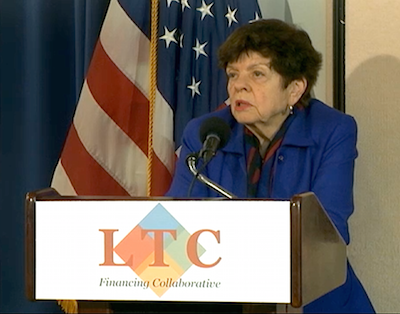
A universal catastrophic insurance program, a series of private-sector initiatives and public policies, and a modernized Medicaid long-term services and supports safety net are the components of a system for financing LTSS in the United States recommended in a report issued Feb. 22 by the Long-Term Care Financing Collaborative.
The group unveiled the report at a press conference hosted by the Convergence Center for Policy Resolution at the National Press Club in Washington, D.C. “A big new entitlement program is probably not in the political cards and might not be desirable either,” speaker Alice Rivlin, Ph.D., a senior fellow at The Brookings Institution, told attendees.
Instead, the diverse group of policy experts and stakeholders from across the political spectrum said that catastrophic insurance could help those who have high care needs over a long period, private-sector initiatives and public policies could revitalize the long-term care insurance market to help address non-catastrophic LTSS risk, and an updated Medicaid safety net could help those with limited lifetime incomes who are not able to save for their care needs and those who deplete their assets paying for medical and long-term care costs.
“We also support efforts to encourage retirement savings and develop more efficient and innovative use of home equity to assist middle-and upper-income families finance LTSS needs for those risks that are not covered by catastrophic insurance benefits,” the report notes.
Speakers at the press conference praised LeadingAge, AARP and The SCAN Foundation for funding modeling by the Urban Institute and actuary Milliman, which facilitated not only the LTCFC’s report but also recent recommendations by LeadingAge and the Bipartisan Policy Center. “We all have come to some core elements that we all think are part of the equation,” Stuart Butler, a senior fellow at the Brookings Institution, told press conference attendees. “Reviving the private insurance industry in LTSS is absolutely essential. To encourage people who can to prepare for eventualities, which they are not doing now. And to reduce the scale of the problem facing the public sector.” Other commonalities between the three groups’ recommendations, he said, include a universal public catastrophic insurance component “both for those who are unable to prepare for the future and for those who are overwhelmed whether or not they prepared,” and the retooling of Medicaid.
The LTCFC began meeting in 2012 with the goal of developing supportable, actionable recommendations for a public and private insurance-based financing system, something it said has eluded policymakers for the past 30 years. In July 2015, the group proposed steps to better integrate LTSS and medical care, support paid caregivers and families, and support communities and employers of caregivers as part of a report titled “Vision of a Better Future for People Needing Long-Term Services and Supports.” The final report builds on that publication.
“There is no single solution to the challenges we face,” the new report states. “We believe that this package of reforms best fits those of all ages who need supports and services. It also best targets public resources to those who most need assistance — people with chronic conditions who face very long and costly periods of LTSS need.”



